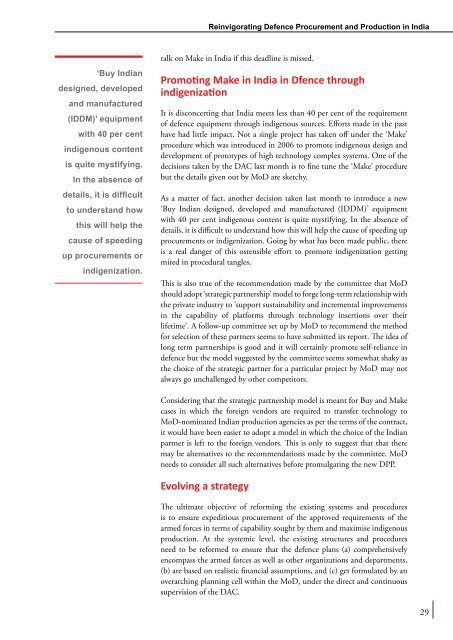Defence Primer
Military_Layout
Military_Layout
Create successful ePaper yourself
Turn your PDF publications into a flip-book with our unique Google optimized e-Paper software.
Reinvigorating <strong>Defence</strong> Procurement and Production in India<br />
‘Buy Indian<br />
designed, developed<br />
and manufactured<br />
(IDDM)’ equipment<br />
with 40 per cent<br />
indigenous content<br />
is quite mystifying.<br />
In the absence of<br />
details, it is difficult<br />
to understand how<br />
this will help the<br />
cause of speeding<br />
up procurements or<br />
indigenization.<br />
talk on Make in India if this deadline is missed.<br />
Promoting Make in India in Dfence through<br />
indigenization<br />
It is disconcerting that India meets less than 40 per cent of the requirement<br />
of defence equipment through indigenous sources. Efforts made in the past<br />
have had little impact. Not a single project has taken off under the ‘Make’<br />
procedure which was introduced in 2006 to promote indigenous design and<br />
development of prototypes of high technology complex systems. One of the<br />
decisions taken by the DAC last month is to fine tune the ‘Make’ procedure<br />
but the details given out by MoD are sketchy.<br />
As a matter of fact, another decision taken last month to introduce a new<br />
‘Buy Indian designed, developed and manufactured (IDDM)’ equipment<br />
with 40 per cent indigenous content is quite mystifying. In the absence of<br />
details, it is difficult to understand how this will help the cause of speeding up<br />
procurements or indigenization. Going by what has been made public, there<br />
is a real danger of this ostensible effort to promote indigenization getting<br />
mired in procedural tangles.<br />
This is also true of the recommendation made by the committee that MoD<br />
should adopt ‘strategic partnership’ model to forge long-term relationship with<br />
the private industry to ‘support sustainability and incremental improvements<br />
in the capability of platforms through technology insertions over their<br />
lifetime’. A follow-up committee set up by MoD to recommend the method<br />
for selection of these partners seems to have submitted its report. The idea of<br />
long term partnerships is good and it will certainly promote self-reliance in<br />
defence but the model suggested by the committee seems somewhat shaky as<br />
the choice of the strategic partner for a particular project by MoD may not<br />
always go unchallenged by other competitors.<br />
Considering that the strategic partnership model is meant for Buy and Make<br />
cases in which the foreign vendors are required to transfer technology to<br />
MoD-nominated Indian production agencies as per the terms of the contract,<br />
it would have been easier to adopt a model in which the choice of the Indian<br />
partner is left to the foreign vendors. This is only to suggest that that there<br />
may be alternatives to the recommendations made by the committee. MoD<br />
needs to consider all such alternatives before promulgating the new DPP.<br />
Evolving a strategy<br />
The ultimate objective of reforming the existing systems and procedures<br />
is to ensure expeditious procurement of the approved requirements of the<br />
armed forces in terms of capability sought by them and maximise indigenous<br />
production. At the systemic level, the existing structures and procedures<br />
need to be reformed to ensure that the defence plans (a) comprehensively<br />
encompass the armed forces as well as other organizations and departments,<br />
(b) are based on realistic financial assumptions, and (c) get formulated by an<br />
overarching planning cell within the MoD, under the direct and continuous<br />
supervision of the DAC.<br />
29


